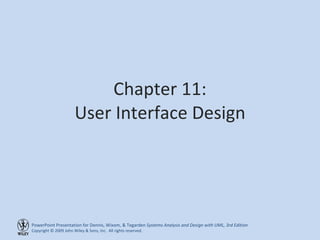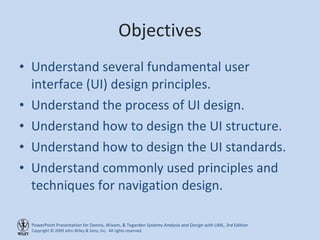Ch11
- 1. Chapter 11: User Interface Design
- 2. Objectives Understand several fundamental user interface (UI) design principles. Understand the process of UI design. Understand how to design the UI structure. Understand how to design the UI standards. Understand commonly used principles and techniques for navigation design.
- 3. Objectives (contĪ»d) Understand commonly used principles and techniques for input design. Understand commonly used principles and techniques for output design. Be able to design a user interface. Understand the affect of nonfunctional requirements on the human-computer interaction layer.
- 4. Overview Interface Design formalizes the interaction of the system with external entities System Interfaces are machine-machine and are dealt with as part of systems integration User Interfaces are human-computer and are the focus of this chapter
- 5. PRINCIPLES OF USER INTERFACE DESIGN
- 6. Principles of User Interface Design Layout Content Awareness Aesthetics User Experience Consistency Minimal User Effort
- 7. General Layout Navigation Area Status Area Reports & Forms Area
- 8. Layout Each area may be further subdivided Each area is self-contained Areas should have a natural intuitive flow Users from western nations tend to read from left to right and top to bottom Users from other regions may have different flows
- 9. Content Awareness Intuitively answers the usersĪ» questions: Where am I? What am I supposed to be doing here? Content awareness applies to sub-areas within a form or window Related form fields (e.g. address information) are grouped together Related report information (e.g. records) are grouped together
- 10. Form Content Awareness Phone Numbers Area Name Area
- 11. Report Content Awareness First Record Area Second Record Area
- 12. Aesthetics Interfaces should be functional, inviting to use, and pleasing to the eye In most cases, less is more (minimalist design) White space is important Acceptable information density is proportional to the userĪ»s expertise Novice users prefer less than 50% density Expert users prefer more than 50% density
- 13. Bad Aesthetics
- 14. User Experience Ease of learning Significant issue for inexperienced users Relevant to systems with a large user population Ease of use Significant issue for expert users Most important in specialized systems Sometimes ease of learning and use of use go hand in hand
- 15. Multiple Interfaces Microsoft Windows has multiple interfaces for the same functionality Most users prefer to use Windows Explorer for handling files Expert users sometimes prefer the command line interface
- 16. Consistency All parts of the system work in the same way Key areas of consistency are Navigation controls Terminology Probably most important concept in making the system simple because it allows the users to predict what is going to happen
- 17. Minimal User Effort Interfaces should be designed to minimize the effort needed to accomplish tasks A common rule is the tree-clicks rule Users should be able to go from main menu of a system to the information they want in no more than three mouse clicks
- 18. USER INTERFACE DESIGN PROCESS
- 19. 5-Step UI Design Process
- 20. Use Scenario Development Use scenarios outline the steps performed by users to accomplish some part of their work A use scenario is one path through an essential use case Presented in a simple narrative description Document the most common cases so interface designs will be easy to use for those situations
- 21. Interface Structure Design The interface structure defines The basic components of the interface How they work together to provide functionality to users Windows Navigation Diagrams (WND) show how all the screens, forms, and reports used by the system are related how the user moves from one to another
- 22. Windows Navigation Diagrams Like a state diagram for the user interface Boxes represent components Window Form Report Button Arrows represent transitions Single arrow indicates no return to the calling state Double arrow represents a required return Stereotypes show interface type
- 23. Sample WND
- 24. Interface Standards Design Interface standards are basic design elements found across the system user interface Standards are needed for: Interface metaphor Interface objects Interface actions Interface icons Interface templates
- 25. Interface Design Prototyping Mock-ups or simulations of computer screens, forms, and reports Four common approaches Storyboard Windows layout diagram HTML prototype Language prototype
- 27. Interface Evaluation Goal is to understand how to improve the interface design before the system is complete Have as many people as possible evaluate the interface Ideally, interface evaluation is done while the system is being designedĪ¬before it is built
- 28. 4 Approaches to UI Evaluation Heuristic Walkthrough Interactive Formal Usability Testing
- 30. Navigation Design Basic Principles Prevent mistakes Simplify recovery from mistakes Use consistent grammar order
- 31. Common Navigation Menu Menu bar Grayed-out commands Drop-down menu Cascading menu
- 32. INPUT DESIGN
- 33. Input Design Basic Principles Online versus Batch processing Capture data at the source Minimize keystrokes
- 34. Types of Inputs Free form Text box Number box Selection box Check box Radio button List box (on-screen, drop-down, or combo) ║▌║▌▀Żrs
- 36. OUTPUT DESIGN
- 37. Output Design Basic Principles Understand report usage Manage information load Minimize bias
- 38. Types of Outputs Detail reports Summary reports Exception reports Turnaround documents Graphs
- 40. Non-Functional Requirements Operational Requirements Technologies that can be used (e.g. GUI, mouse) Performance Requirements User interface took kit speed and capacity Security Requirements Restricted user interface (e.g. an ATM machine) Political & Cultural Requirements Date formats, colors and icons
- 41. Summary Principles of User Interface Design User Interface Design Process Navigation Design Input Design Output Design Nonfunctional Requirements









































